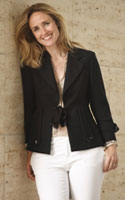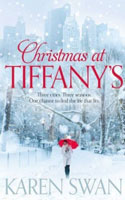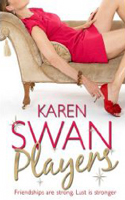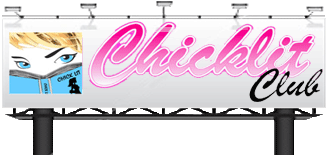INTERVIEW
November 2011

KAREN SWAN
Karen Swan worked in fashion journalism before plunging into the world of fiction. She has written three books, Players, Prima Donna and Christmas at Tiffany's. Her fourth book is due out next December. She is married with three children and lives in Sussex. (Interview by Angela Smith)
Return to interview list
-

1. Tell us about your latest novel Christmas At Tiffany's?
The story begins with a glamorous party on a Scottish shooting estate, being thrown to celebrate Cassie and Gil Fraser’s 10th wedding anniversary. It is mainly populated by Gil’s circle of friends, but Cassie’s three beloved best friends have flown in from their far-flung corners – New York, Paris and London – to celebrate with her. Unfortunately, during the course of the evening, Cassie learns something that makes her marriage instantly and completely unviable and she finds herself, overnight, having to start afresh and alone. But she married young, she’s never had a paid job and she’s spent all of her adult life in the remote Highlands so technology, fashion and the perils of dating have all passed her by. Her three best friends argue about who knows what and where is best for her to start her new life, until eventually they arrive at an agreement: she will spend the next year staying with each of them for four months, allowing them to mould her into their visions of the Cassie she should be. It’s not a smooth path!
-
2. Where did you get the inspiration for the main character, Cassie?
Cassie was a lovely character to write and I was protective of her from the off. What happens to her in the prologue makes her vulnerable and an instantly sympathetic character to the reader. She clearly moves in a grand circle, but it’s her husband’s world, and older than her, so her journey is one of rebuilding herself, bit by bit - not just in finding her identity but also reclaiming her youth. With Tor in Players and Pia in Prima Donna, I enjoyed taking apart and rebuilding characters who were initially brittle and standoffish, and gradually softening them. But with Cassie it’s the opposite - she starts out lovely, trusting and naive, and actually part of what she has to learn is how to toughen up and say no. I used her physicality to suggest a lot of her personality, so she has an easy and ready smile and her eyes are wide and trusting. I also deliberately made her hair long and dark blonde. A lot of people have subsequently thought that she is therefore based on me, as my hair is like that, but it was a more tactical decision – the dark blonde shows she didn’t bother with anything so high-maintenance as highlights in her previous life, plus it leaves lots of scope for colouring and chopping throughout the book!
-
3. Do you source your characters and plots from real people or situations?
I never base the characters directly on people I know, although I will quite often use pictures of random people that ‘feel’ right, until I ‘know’ the character better; then once they’re fully formed in my mind, I forget all about my visual prop. So, the character of Anna in Players was prompted by a model in the Pure cashmere catalogue; Will Silk in Prima Donna was kicked off from an article in the financial section of the London Evening Standard, and Anouk in Christmas at Tiffany’s is directly based on a stunning French woman who was featured in a TV episode of MasterChef. As soon as I saw her, I knew she was Anouk and I recorded the episode, coming back to it repeatedly, pausing it and staring at her for ages, trying to imagine who she was and how she might behave. In the book I’m currently writing (due out December 2012), I was halfway through when I delightedly found my character in the society pages of Grazia magazine. I’ve cut her out and taped her to the screen on my laptop. I Googled her and discovered she has a very, very influential mother-in-law, but she’ll never know of her role in my book! Plot-wise, I only ever use real situations in terms of locations. So in Christmas at Tiffany’s, much of what happens in the Paris section is directly attributable to a trip I took there with my two sons. I had been to the city many times before (for the International Collections – and to New York too) but it was with them that I first saw the Laduree store and the street markets, but most particularly the Pont des Arts and its padlocks which are so central to the book.
-
4. Do you think every novel needs a villain?
Yes, although they don’t necessarily have to be evil or dangerous or sinister. They can be irritating, boring, dull, repetitive - you simply need them as a counter-point for the main character. In Christmas at Tiffany’s the villain is very much off-screen for most of the book; It is his actions which enable Cassie to free herself and move forward - it would never have come from her otherwise – but the book isn’t concerned with him beyond that. He’s purely a vehicle for Cassie’s personal growth.
-
5. How easy or hard did you find the transition from fashion editor to author?
Pretty easy actually. It’s only with hindsight that I realize my career was a constant editing down to this point that I’m at now. Writing was always my skill set – all my school reports noted my writing style - to the point that everyone always said I’d become a writer and it seemed too predictable somehow. I’m terribly contrary like that. So after I finished my English degree, I set off for the fashion world, and got a job at Tatler assisting styling on shoots. But I got quickly bored with it. One time we’d gone all the way to Paris to do a shoot in a studio, but when the prints came in (the days before digital) the editor hated them and we had to reshoot. When those prints came back – in London, different model – I honestly couldn’t see what was any better with them. I knew then that styling wasn’t for me so I moved magazines and over to fashion features, interviewing and writing for Vogue. Again, great for a bit but I began to go a bit mad with the pendulum swing of fashion – if it’s black this season, it’ll be white next - and so I moved to YOU magazine and into general features, interviewing non-fashion folk on a whole range of subjects – celebrity, human interest … But I was editing, not writing, in that role and could hardly bear having to give the commissions to other writers when I was itching to write them myself. It was only when I left on maternity leave that I was finally able to just sit down in front of my computer, think of a story and write it.
-
6. Do you think your background in fashion helps you create your characters’ styles and personalities?
Yes definitely, to the point where I have real trouble if I have to describe a character with no clue in clothes. I almost can’t do it. My mind blanks. There’s a scene in Christmas at Tiffany’s where I have to describe Cassie turning up for work in Manhattan in her own clueless ensemble. That scene was just a series of XXXXXXXXXs for so long because I literally couldn’t imagine what a hideous combination would be. It’s tragic actually. The clothes in my books are usually highly indicative of wealth, class, nous and changed circumstance –there’s a hilarious scene showing exactly that with Anouk towards the back of Christmas at Tiffany’s. It still makes me chuckle to think of it.
-
7. What do you do when you are not writing?
I wish I could say sleep and shop more but it’s mainly picking up my children’s clothes and toys off the floor. I also cook and bake loads! Every morning I either run or walk with dog on the Ashdown Forest, it gives me a huge burst of air for the day which is great when you spend so much time sitting still indoors staring at a screen. I also do an advanced dance class once a week (although I wish it could be more) and I’m great with a sewing machine. I make all my own curtains, blinds, bed valances, cushions … you name it. Basically, I’m just never still and too long awake.
-
8. Out of all your books so far - Players, Prima Donna and Christmas at Tiffany's - which was your favourite to write?
Christmas at Tiffany’s definitely. I loved the whole concept of that book right from the word go. It gave me prickles up my arm when I came up with the idea for it and I just couldn’t wait to get started with it. Aside from the obvious splitting up into three distinct sections, it had a definite ebb and flow to writing it too. New York had to pack a punch and leave you reeling and slightly breathless; there was so much action to get into there, as it really had to have a very strong dynamic vibe. Paris was definitely the trickiest city to write about. I needed the romance and glamour of the city to come across but because it needed to contrast with New York – which was all light and ambition and energy - I wanted the pace to feel slower, moodier and darker; I also had to get in a more ominous sense of her new life being on shaky foundations and everything unravelling again. The London section I just adored writing. As the finale, invariably there’s an uplift, and my fingers literally flew over the keyboard. I knew the characters so well by then, they were my new BFFs, and I just couldn’t wait to wrap it all up - like a Tiffany box! It was fun from start to finish. If only all books were that easy…
-
9. Is there a theme or idea that you'd love to work with on a future book?
I’ve found I do like to have a motif – a way of imparting information other than through conversation or narrative, such as letters, postcards etc – and it lets you leave clues throughout the book. So in Christmas at Tiffany’s I used lists for Cassie to follow in each of the cities, but I also played with the language of flowers for the sub-plot. And my next book – out December 2012 - is set around a charm bracelet that tells the character’s life story through the charms. It’s a love story where nothing is as it seems.
-
10. Where is your favourite place to go to write?
In the summer, when it’s warm enough, I go down to our treehouse at the bottom of the garden. It can be a bit tricky getting there as there’s a rope bridge to navigate, which isn’t easy with a laptop, notebook, file and cup of tea in your hands, but the views up the garden are worth it. Otherwise, I’m in the snug, looking out at the garden. It’s got a beautiful wisteria-print wallpaper which makes me feel like I’m in a bower and one wall is lined completely with books which I scan when I’m trying to come up with characters’ names. My daughter’s massive Wendy house sits on the wall behind me and sometimes she goes in and plays in there whilst I’m working. I love listening to her humming whilst she plays. After Christmas I’m going to have to relocate to the kitchen though. Our dog is having puppies and I’m going to have to stick close by her to keep an eye on them all.
-
11. What is your favourite chick lit book?
A controversial answer but I’m going to say Jane Austen’s Pride and Prejudice. Lizzie Bennet is truly a woman before her time – feisty, opinionated, clever, witty and alluring for it. The issues she faces are just the same as the ones I love to read and write about now, simply in a period setting. I return to her again and again.
-
12. If you could have dinner with one person, dead or alive, who would it be?
Alexander McQueen. His death is such a genuine loss to the world as a whole. He was a true visionary, one of a generation and there was just so much more that he had yet to give. I think he would have terrified me though, so maybe I’d have had to sit at a nearby table and eavesdrop!
-
13. Which of your characters would you most/least to invite to dinner?
Oh, the Christmas at Tiffany’s girls, definitely. And their boys. Suzy and Arch are my favourite couple by a long way. I could write about them till the cows come home - in fact, I haven’t entirely discarded the idea of revisiting them in another book. I so wish they were real. I’m genuinely sad they aren’t. The one not making it to my dinner table is Violet in Prima Donna. Ava Petrova is Pia’s true nemesis but she has her own tragedies and the fact she is Pia’s equal would make her interesting to talk to at least. But Violet is a shadow on the sidelines and almost more damaging for it. She’s vain, proud, selfish, egocentric and jealous. I found nothing redeeming in her at all and as much as Pia started out a brat, she ends with a big, healed heart. Violet does not.
-
14. What was your life like before becoming an author? What changed the most for you after you were published?
To be honest, I was in the throes of having my family so it was very mundane and practical. I was three months pregnant with my third child when I started writing Players and even though I sat down with no big overview of what I was going to write, once I got into the habit of retreating into my head, it was addictive. I think it was such a contrast to my everyday life of doing the nursery runs, changing nappies, blending purees etc that to delve back into all the best elements of my old life (where I would routinely travel, party and interview people like Jude Law or Manolo Blahnik, Cath Kidston or Tracy Emin) was intoxicating. I had had insider access to a closed and very aspirational world and suddenly I got to fuse that with my skill set and write these glamorous, pacy books. What’s changed for me since being published is the belief I have in myself. I’m entirely self-taught. I’d never written so much as a poem or short story before writing Players, and it was whilst writing Christmas at Tiffany’s that I really accepted that I knew how to do this. It hadn’t been a fluke after all! Plus, before I was signed up, I felt like writing was a selfish indulgence, whereas now I’m perfectly entitled to pull a po face and mutter things like ‘deadline looming / it’s not going to write itself’ and retreat gleefully to the snug. Bliss!
-
15. Which of your characters is most/least like you?
I think I was so determined to be able to rebut the accusation that any of my characters were me that it’s only really in my third book, Christmas at Tiffany’s, that I’ve allowed certain elements through. For example, Cassie’s strange fear of cats and their retractable claws? Totally me! Her problems waking up in the morning? Totally me. Her desperate need for tea? Totally me. Plus we share hair. But I’m still not Cassie. I’m far more opinionated and punchy than she is and I’m happy to say I’m perfectly capable of getting dressed without having my clothes numbered into outfits for me! Overall, I’m probably more like Suzy – the London friend in the book. Suzy’s sense of humour is very much mine, and I guess I have to admit I’m bossy too. Plus I do love cake and my mum and I have a very handsome brother. The character I’m like least? Pia Soto in Prima Donna, probably not a great surprise. No one’s ever accused me of being in any way like a brilliant, diminutive Brazilian ballerina with an attitude problem!


